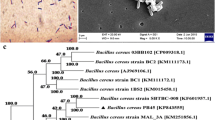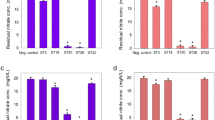Abstract
A bacterial strain PB88 was isolated from intensive shrimp culture pond to study the denitrification process. On the basis of 16S rDNA analysis, strain PB88 was identified as Bacillus cereus PB88. It has the potential to remove 82.33 ± 3.24% \({\text{NO}}_{2}^{ - } {-} {\text{N}}\)in synthetic medium. The optimum pH, temperature and dissolved oxygen for the highest denitrification process of the PB88 were 8.0, 30 °C and 5.21 mg/l (150 rpm) respectively. PB88 harbour the genetic sequence of nitrite reductase (nirS) enzyme which is essential to complete aerobic denitrification process. One remarkable finding is that the experimental organism produced exopolysaccharide (EPS) during the denitrification process and EPS has the antibacterial property against shrimp pathogen Vibrio harveyi MTCC 7954 (inhibition zone of 5.21 mm) and Vibrio vulnificus MTCC 1145 (inhibition zone of 7.11 mm). Removal of \({\text{NO}}_{2}^{ - } {-} {\text{N}}\) in open base shrimp wastewater system were recorded as 98.51% by B. cereus PB88 and average shrimp body weight gained in treated system as 6 ± 0.54 to 8 ± 0.74 g within 7 days. Overall result indicated that B. cereus PB88 has the immense potential for the application in commercial shrimp culture as denitrifying agent.








Similar content being viewed by others
References
Food and Agricultural Organization of the United Nations: The State of World Fisheries and Aquaculture 1998. p. 112. Food and Agriculture Organization FAO, Rome (2006)
Yung, C.S., Leung, P., Lin, B.H.: Comparative economics of shrimp farming in Asia. Aquaculture. 164, 183–200 (1998)
van Rijn, J.: The potential for integrated biological treatment systems in recirculating fish culture-a review. Aquaculture 139, 181–201 (1996)
Hopkins, J.S., Sandifer, P.A., Browdy, C.L.: Sludge management in intensive pond culture of shrimp: effects of management regime on water quality, sludge characteristics, nitrogen extinction, and shrimp production. Aquac. Eng. 13, 11–30 (1994)
Smith, P.T.: Physical and chemical characteristics of sediments from prawn farms and mangrove habitats on the Clarence River, Australia. Aquaculture 146, 47–83 (1996)
Lin, S.H., Wu, C.L.: Electrochemical removal nitrite and ammonia for aquaculture. Water Res. 30, 715–721 (1996)
Read, P., Fernandes, T.: Management of environmental impacts of marine aquaculture in Europe. Aquaculture 226, 139–163 (2003)
Wang, Y.B., Xu, Z.R., Deng, Y.S.: Toxicity of ammonia and nitrite to aquaculture and the control measures. Feed. Ind. 23, 46–48 (2002)
Song, Z.F., An, J., Fu, G.H., Yang, X.L.: Isolation and characterization of an aerobic denitrifying Bacillus sp. YX-6 from shrimp culture ponds. Aquaculture. 319, 188–193 (2011)
Li, P., Zhang, S., Liu, D.L.: Study progress of bacterial aerobic denitrification. J. Microbiol. 25, 60–64 (2005)
Li, Y.Q., Zhang, H.Y., Li, J., Wang, Q.Y., Li, Z.D.: Utilization of liquid oxygen in intensive shrimp aquaculture. Fish. Sci. 27, 401–403 (2008)
Staudt, C., Horn, H., Hempel, D.C., Neu, T.R.: Volumetric measurements of bacterial cells and extracellular polymeric substance glycoconjugates in biofilms. Biotechnol. Bioeng. 88, 585–592 (2004)
Flemming, H.C., Wingender, J.: Extracellular polymeric substances (EPS): structural, ecological and technical aspects. In: Bitton, G (ed.) Encyclopedia of Environmental Microbiology. pp. 1223–1231. John Wiley & Sons, New York (2002)
Kolter, R., Greenberg, E.P.: Microbial sciences: the superficial life of microbes. Nature 441, 300–302 (2006)
Sutherland, I.W.: The biofilm matrix—an immobilized but dynamic microbial environment. Trends. Microbiol. 9, 222–227 (2001)
Orsod, M., Joseph, M., Huyop, F.: Characterization of exopolysaccharides produced by Bacillus cereus and Brachybacterium sp. isolated from Asian Sea Bass (Latescalcarifer). Malays. J. Microbiol. 8(3), 170–174 (2012)
Barman, P., Bandyopadhyay, P., Mondal, K.C., Das Mohapatra, P K.: Improved cultivation of Black Tiger Shrimp by the application of microorganisms and novel biomolecules. Asian J. Sci. Techol. 6(7), 1624–1630 (2015)
Karunasagar, I., Pai, R., Malathi, G.R., Karunasagar, I.: Mass mortality of Penaeus monodon larvae due to antibiotic-resistant Vibrio harveyi infection. Aquaculture. 128, 203–209 (1994)
Barman, P., Bandyopadhyay, P., Mondal, K.C., Das Mohapatra, P.K.: Water quality improvement of Penaeus monodon culture pond for higher productivity through bioremediation. Acta. Biol. Szeged. 59, 169–177 (2015)
Takaya, N., Antonina, M., Catalan-Sakairi, M.A., Sakaguchi, Y., Kato, I.: Aerobic denitrifying bacteria that produce low levels of nitrous oxide. Appl. Environ. Microbiol. 69, 3152–3157 (2003)
Kumar, A., İnce, İ.A., Kati, A., Chakraborty, R.: Brevibacteriumsiliguriense sp. nov., a facultatively oligotrophic bacterium isolated from river water. Int. J. Syst. Evol. Micr. 63, 511–515 (2013)
Braker, G., Fesefeldt, A., Witzel, K.P.: Development of PCR Primer Systems for Amplification of nitrite reductase genes (nirK and nirS) to detect denitrifying bacteria in environmental samples. Appl. Environ. Microbiol. 64, 3769–3775 (1998)
Braker, G., Zhou, J., Wu, L., Shou, J.Z., Allan, H.: Nitrite reductase genes (nirK and nirS) as functional markers to investigate diversity of denitrifying bacteria in Pacific North West marine sediment communities. Appl. Environ. Microbiol. 66, 2096–2104 (2000)
AWWA WPCF.: Standard Methods for the Examination of Water and Wastewater. 21st edn, AWWA, Washington DC (2005)
Ruiz, C.M., Roman, G., Sanchez, J.L.: A marine bacterial strain effective in producing antagonisms of other bacteria. Aquacult. Int. 4, 289–291 (1996)
Arts, P.A.M., Robertson, L.A., Kuenen, J.G.: Nitrification and denitrification by Thiosphaerapantotropha in aerobic chemostat cultures. FEMS Microbiol. Ecol. 18, 305–316 (1995)
Joo, H.S., Hirai, M., Shoda, M.: Characteristics of ammonium removal by heterotrophic nitrification-aerobic denitrification by Alcaligenes faecalis No. 4. J. Biosci. Bioeng. 100, 184–191 (2005)
Li, C., Yang, J., Wang, X., Wang, E., Li, B., He, R., Yuan, H.: Removal of nitrogen by heterotrophic nitrification-aerobic denitrification of a phosphate accumulation bacterium Pseudomonas stutzeri YG-24. Bioresour. Technol. 182, 18–25 (2015)
Mevel, G., Prieur, D.: Heterotrophic nitrification by a thermophilic Bacillus species as influenced by different culture conditions. Can. J. Microbiol. 46, 465–473 (2000)
Gupta, A.B.: Thiosphaeera Pantotropha a sulphur bacterium capable of simultaneous heterotrophic nitrification and aerobic denitrification. Enzyme Microb. Technol. 21, 589–595 (1997).
Timmermans, P., Van, H.A.: Fundamental study of the growth and denitrification capacity of Hyphomicrobium sp. Water. Res. 17, 1249–1255 (1983)
Zhang, J.B., Wu, P.X., Hao, B., Yu, Z.N.: Heterotrophic nitrification and aerobic denitrification by the bacterium Pseudomonas stutzeri YZN-001. Bioresour. Technol. 102, 9866–9869 (2011)
Ole, F., Maurizio, B., Francesca, C., Serena, R., Scot, W., Israel, P.: Intramolecular electron transfer in Pseudomonas aeruginosa cd1 nitrite reductase: thermodynamics and kinetics. Biophys. J. 96, 2849–2856 (2009)
Philipport, L., Mirleau, P., Mazurier, S., Siblot, S., Hartmann, A., Lemanceau, P.: Characterization and transcriptional analysis of Pseudomonas fluorescens denitrifying clusters containing the nar, nir, nor and nos genes. Biochim. Biophys. Acta. 1517, 436–440 (2001)
Barman, P., Kati, A., Mandal, A.K., Bandyopadhyay, P., Das Mohapatra, P.K.: Biopotentiality of Bacillus cereus PB45 for nitrogenous waste detoxification in ex situ model. Aquacult. Int (2016). doi: 10.1007/s10499-016-0105-y
Her, J.J., Huang, J.S.: Influences of carbon source and C/N ratio on nitrate/nitrate denitrification and carbon break through. Bioresour. Technol. 54, 45–51 (1995)
Yang, X.P., Wang, S.M., Zhang, De-W., Zhou, L.X.: Isolation and nitrogen removal characteristics of an aerobic heterotrophic nitrifying–denitrifying bacterium, Bacillus subtilis A1. Bioresour. Technol. 102, 854–862 (2011)
Guo, L., Chen, Q., Fang, F., Hu, Z., Wu, J., Miao, A., Xiao, L., Chen, X., Yang, L.: Application potential of a newly isolated indigenous aerobic denitrifier for nitrate and ammonium removal of eutrophic lake water. Bioresour. Technol. 142, 45–51 (2013)
Duan, J., Fang, H., Su, B., Chen, J., Lin, J.: Characterization of a halophilic heterotrophic nitrification-aerobic denitrification bacterium and its application on treatment of saline wastewater. Bioresour. Technol. 179, 421–428 (2015)
Gupta, A., Gupta, S.: Simultaneous carbon and nitrogen removal from high strength domestic wastewater in an aerobic RBC biofilm. Water. Res. 35, 1714–1722 (2001)
Patureau, D., Helloin, E., Rustrain, E., Bouchez, T., Delgenes, J.P., Moletta, R.: Combined phosphate and nitrogen removal in a sequencing batch reactor using the aerobic denitrifier, Microvirgulaaero denitrificans. Water. Res. 351, 189–197 (2001)
Karthikeyan, J.: Aquaculture (shrimp farming), its influence on environment. American Society of Civil Engineers, Calcutta (1994)
Acknowledgements
The authors are thankful to Mr. D. K. Chopra group CEO of Biostadt India Limited, Mumbai, India for his kind support and Mr. Pravas Singh Assistant professor, Department of Computer Science, Vidyasagar University for development of equation.
Author information
Authors and Affiliations
Corresponding author
Ethics declarations
Conflict of interest
The authors declare that they have no conflict of interest.
Rights and permissions
About this article
Cite this article
Barman, P., Bandyopadhyay, P., Kati, A. et al. Characterization and Strain Improvement of Aerobic Denitrifying EPS Producing Bacterium Bacillus cereus PB88 for Shrimp Water Quality Management. Waste Biomass Valor 9, 1319–1330 (2018). https://doi.org/10.1007/s12649-017-9912-2
Received:
Accepted:
Published:
Issue Date:
DOI: https://doi.org/10.1007/s12649-017-9912-2




